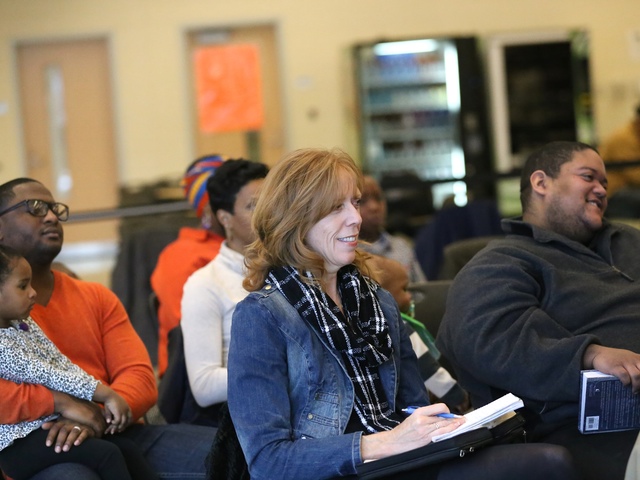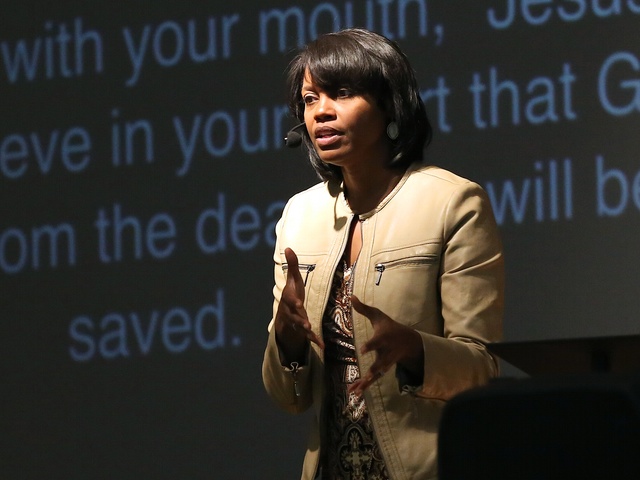This story was originally published in January 2014.
CINCINNATI – On Sunday morning, a high school cafeteria becomes a place of worship, with the lunch tables’ chairs lined up instead of pews and the stage transformed into an altar.
Followers of Christ sing lyrics that flash across a screen on the stage, swaying and clapping in time with the music, some lifting their arms in prayer.
“What a wonderful God we serve,” Pastor Sherman Bradley tells the congregation during the service.
“Lord yes!” members of the congregation respond.
On the Sunday before Martin Luther King, Jr. Day, it’s not easy to find a church whose congregation looks like the multi-racial dream King described in his famous 1963 speech: A society where all of God’s children work, pray and struggle together.
But that’s exactly what Sherman and Sadell Bradley are working to build as co-pastors of New Life Covenant Cincinnati. After several years of preparation, the couple started the fledgling church last March to create a “multi-ethnic, inter-generational, multi-class community” to serve the downtown, Over-the-Rhine and West End communities.
“It is our passion, as it was with Dr. King, to see those divides broken, those gaps filled in,” Sherman Bradley said in an interview.
“There is an equalization in the gospel of Jesus,” Sadell Bradley added. “This is what we believe the Kingdom of God looks like.”
'Important And Difficult'
The Bradleys’ congregation is small but enthusiastic. The Jan. 19 service had around 40 people, despite the snow and cold. The group was about two-thirds black, the rest white, ranging from tiny babies carried in car seats to white-haired adults. Some were homeless men and women from the nearby City Gospel Mission. Others drove there in Cadillacs, Volvos and Toyotas.

Steve and Linda Faulkner are among the white parishioners have been going to the services each Sunday for the past three or four months.
“Every time I come in, I just feel the presence of God,” said Steve Faulkner. “I know I’m going to find some good friends here, some good, Godly men.”
“I haven’t walked into a church where I’ve felt more comfortable,” added his wife, Linda.
Tim and Leslie Baker aren’t members of the church. But the couple has been driving from their Colerain Township home occasionally for months to support New Life.
“I truly think they’re really trying to represent what Christ is to this world,” Leslie Baker said. “As a bi-racial couple, it’s not always easy to go into a church of worship because it’s pretty much a mono-ethnic type of environment. To be here has always been very welcoming.”
Added her husband: “We want to see them succeed.”
The Bradleys want New Life to be even more diverse, and Sherman Bradley is working on it. He visits groups that cater to Hispanic and Asian members and invites everyone to come check out the church, he said.
Services are held from 11 a.m. to 12:30 p.m. each Sunday in the cafeteria of Robert A. Taft High School on Ezzard Charles Drive.
It’s not uncommon for a new church to start in such a location, said Adair Lummis, a faculty research associate at the Hartford Institute for Religious Research in Hartford, Conn.
But starting a new church that has a congregation of different races, ages and income levels is far more rare – and far more difficult, Lummis said.
“Everyone wants a diverse congregation, but trying to get a diverse congregation is difficult,” she said. “It’s important and difficult.”
That’s because people typically want to go to church with people who are like them, she said.
'Needle In A Haystack'
The Hartford Institute’s research indicates fewer than 15 percent of the nation’s churches have “multi-ethnic” congregations, Lummis said, meaning no more than 80 percent of the congregation is from the same race.
Of those congregations, most are comprised primarily of white parishioners, she said, and they rarely have black pastors leading them.

The Bradleys understand all that, and they don’t expect their journey to be easy.
“The thing God is calling us to do is not a common thing,” Sadell Bradley. “What we’re embarking on – it’s kind of like the proverbial needle in a haystack.”
Still, the couple is determined.
Sadell Bradley knew long before she ever met her husband that she would help start a church someday, she said.
“Pastoring is something that you have to feel called to do,” she said. “You’re there with people at the best of times, but you’re also there at hospitals and funerals. It’s something that you really have to count the costs to see if God is really calling you to do it.”
The work is part of Sherman Bradley’s DNA.
His uncle, Edward Orlando Thomas, was a pastor in Walnut Hills for 25 years. In fact, Thomas and four other pastors went to Texas in the mid-1970s to convince the Rev. Billy Graham to visit Cincinnati to help heal the city’s lingering strife after the race riots of the late 1960s, Bradley said.
“My mother says I remind her of him,” he said.
The Bradleys met in late 2001 at a Christian singles event. They had similar ideas about helping people. They both felt a calling to ministry, and each of them wanted to marry someone in ministry.
Sherman Bradley, 48, is a Greater Cincinnati native and Forest Park High School graduate. He spent about 10 years working for City Gospel Mission, helping run the nonprofit’s homeless shelter and drug rehab program. Sadell Bradley, 46, grew up in Philadelphia and graduated from the University of Pennsylvania. She moved to Cincinnati for work here and has worked in ministry locally since 1991, spending 14 years at Christ Emmanuel Christian Fellowship.
The two were members of Peoples Church in Walnut Hills before starting New Life.
Like New Life, Peoples Church is multi-ethnic, but it didn’t start out that way. Peoples was founded in 1906 as Christian Catholic Apostolic Church.
It was a 98 percent white commuter church in 2004 when it adopted a vision “to be a racially reconciled, generationally rich, life giving church thriving in the heart of the city.”
The church lost quite a few members who didn’t like the change, said Tom Baxter, an associate pastor there.
Trying To 'Represent Heaven'
But it has since become a congregation that is about half white, 25 percent black and 25 percent international representing 30 different nations, Baxter said.
Because of its own experience, Peoples supports the Bradleys’ vision for New Life Covenant, Baxter said.

“Churches that are open and accepting of all people are in the minority,” Baxter said. “There’s a need for churches that represent heaven.”
Peoples Youth Pastor Dele Okuwobi agreed.
“Churches for a long time have been comfortable with really just doing away with the commandment to love your neighbor and love all people,” Okuwobi said.
“A church like Sherman’s and Sadell’s – if you’re looking for a church, and you look through those church doors, you’ll see someone like yourself, and you’ll feel welcomed.”
Peoples has offered more than spiritual support.
Peoples and New Life share the same board of directors, Sadell Bradley said. And Peoples has also give the Bradleys financial support and help with strategic planning, Baxter said.
The Hartford Institute’s Lummis said that support will continue to be important as New Life becomes more established.
She predicted that growing the church and staying true to its mission could become even more difficult after its first year after its “newness” wears off.
Money For The Mission
The Bradleys know they must raise money to keep New Life going.
To do that, they are hosting Dr. John Perkins for a series of community gatherings and fundraisers on March 14, 15 and 15.
Perkins, a minister and Civil Rights leader in Mississippi, was the founder of the Christian Community Development Association, a network of congregations and organizations that work to restore urban communities guided by Biblical principles.
The weekend will start with a community concert March 14 at Peoples Church in Walnut Hills, a free community brunch event at Taft High School March 15 and a special Sunday service, led by Perkins, at Taft High on March 16.
All the public events will be free. People will be asked to register in advance, and they will have a chance to contribute if they feel inspired by New Life’s mission, Sherman Bradley said.
The Bradleys don’t have a set goal in mind for how much they want to raise, but Sadell Bradley said the downtown building they hope to buy and transform into their church home would cost about $200,000.
“It’s hard to gauge the need because it seems endless,” Sherman Bradley said.
And the church’s work already has begun.
Beyond the weekly services, New Life is working to provide after-school programs that help with local students’ character development. And last June the church sponsored HopeFest Festival, a free event in Over-the-Rhine’s Washington Park that offered music, games, giveaways and health screenings for needy children in Over-the-Rhine and the West End.
There’s so much more the Bradleys want to do, so many more ways they want to bring opportunities to areas that have been forgotten in the city’s ongoing revitalization.
A critical step in that journey, though, is truly knowing the poor and bringing people from different backgrounds together in meaningful ways, Sadell Bradley said.

And that is what New Life is all about.
“New Life isn’t just a social experiment,” Baxter said. “They’re such a blessing to the community they’re in.”
For more information about New Life Covenant Cincinnati, go to http://www.mynewlifecincinnati.com. To register for the community events in March, email info@mynewlifecincinnati.com.
For more stories by Lucy May, go to www.wcpo.com/may. Follow her on Twitter @LucyMayCincy.



